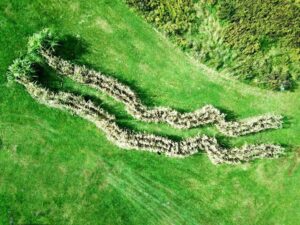
Over the course of summer and fall, LAB participating artist Emilio Rojas worked closely with the Bard Farm Coordinator and Educator, Rebecca Yoshino, to plant and then harvest a 72-foot-long line of indigenous crops growing in the shape of the U.S.-Mexico border. This interactive land art installation is one part of Rojas’s project for LAB, entitled, Naturalized Borders (to Gloria). In this post, Yoshino shares her knowledge of the indigenous history of the land on which the Bard College Farm is located, and the crucial relationship between the three crops planted for this project.
The Bard campus and farm is located on the ancestral homelands of the Muhheaconneok or Mohican people, known today as the Stockbridge-Munsee Mohican Nation. They were stewards of the land and like so many indigenous communities across the Americas were actively cultivating crops both within established gardens as well as enhancing habitat and promoting varietal development of edible wild plants within their natural environments. We must remember that our rich agricultural history here in the Hudson Valley begins many generations before European contact by Haudenosaunee communities across our region.
The plants in this installation pay homage to the resilience and adaptation of communities, the land and environment that have survived genocide, assault, assimilation and systematic attempts of eradication under colonization.These plants are a living testament.
This installation is in the shape of the US, Mexican border and is planted with corn, squash, beans and teosinte. The gate-keeper of the garden is teosinte, a native grass to Mexico that through many generations of selection by indigenous communities who recognized its food value eventually developed into what we know today as corn. From teosinte the garden transitions to a Three Sisters configuration of corn, squash and beans, planted in mounds, one of the many traditional methods used by indigenous communities in Central and North America to establish these crops.
The plants work together in a symbiotic relationship, the corn provides poles for the beans to climb, the beans fix nitrogen in the soil for the heavy feeding corn while providing additional anchored support for its stalks and the squash provides a ground cover that suppresses weeds, helps regulate soil temperatures and moisture and provides a pest barrier with its deterring prickly leaves and stems. These plants when eaten together provide a complete plant based nutritional diet rich in protein, fiber, carbohydrates, omega fatty acids and micronutrients. They are a reminder of our inter and co-dependence within community and our environment.
The garden then transitions to a monoculture planting of corn in long straight rows, reflective of contemporary conventional US agricultural practices that are devastating human, soil, water and climate health. Our current land use practices are the second largest contributor to greenhouse gas emissions and corn now occupies ¼ of all cultivated land in the United States, over 90 million acres. This ancestral plant found in many indigenous communities origin stories, stewarded and transformed into hundreds of regional varieties sustaining health, well-being and interconnection with living cycles, natural systems and the sacred, now appropriated and used primarily to feed livestock, in systems that deny our planet and human community a stable future.
The plants serve as a reminder of how we have evolved over time and transformed resources within our environment to meet cultural needs while forming foundational blocks of our own cultural identity. They are a reminder of the devastating effects of colonization and the impacts of a patriarchal, domination based approach to land use, agriculture and resource management. And finally they are a reminder of the resilience of indigenous communities and our natural environment who refuse to be silenced, assimilated, compliant or locked away in dusty archives to be forgotten. The teosinte, Haudenosaunee Cornbread Bean, Seneca Buffalo Creek Squash and Dakota Yellow Flint Corn, celebrate the revitalization of indigenous foodways, stewardship and re-connection of seed relatives to communities of origin and sacred homelands, where one day we hope, no border remains.
